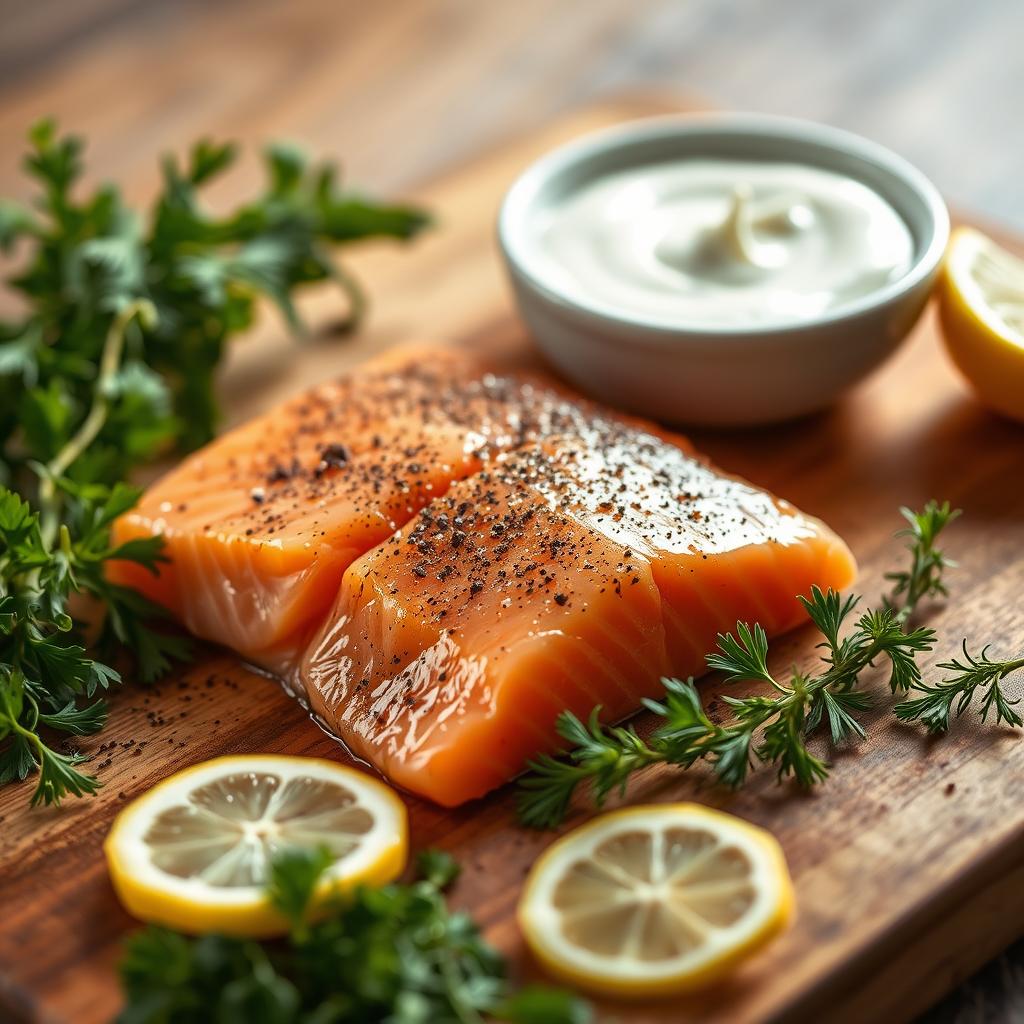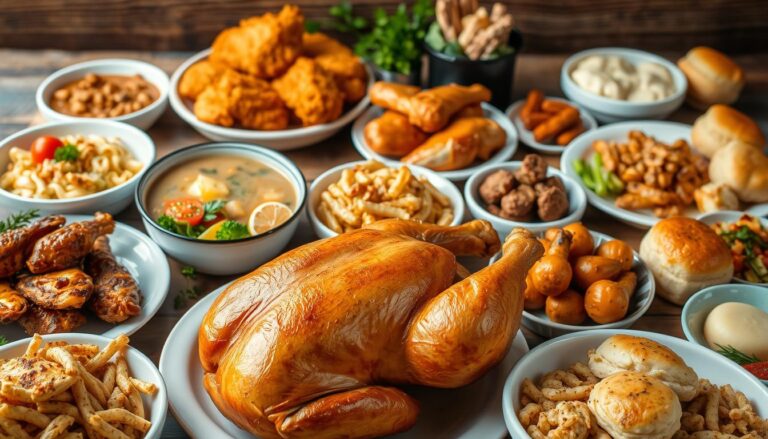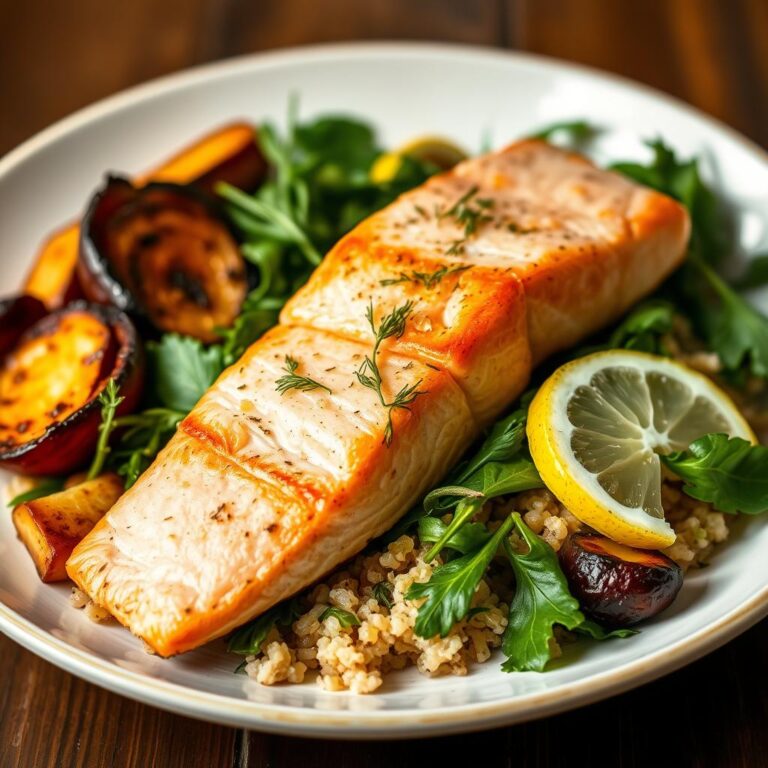Salmon in Parchment Paper Recipe: Simple and Healthy Salmon in Parchment
Imagine a kitchen full of life, with the smell of fresh herbs everywhere. The salmon in parchment method is more than a recipe. It’s a way to make healthy, easy meals at home.
Think about making a healthy salmon dish that’s easy to clean up and tastes amazing. Cooking salmon in parchment paper is a French secret. It keeps the fish moist and adds a lot of flavor.
If you’re always on the go or want to impress your guests, this method is perfect. It’s simple yet fancy. You can make dishes that look like they came from a restaurant, all in your own kitchen.
Key Takeaways
- Salmon in parchment is a foolproof cooking method
- Minimal ingredients, maximum flavor profile
- Healthy cooking technique preserves nutritional value
- Perfect for weeknight dinners and special occasions
- Requires minimal cleanup and preparation time
Understanding En Papillote Cooking Method
Discover the elegant French cooking technique that turns simple ingredients into culinary masterpieces. En papillote cooking is a delightful method that brings out the best flavors in your favorite dishes, like salmon.
What Does En Papillote Mean?
En papillote literally means “in paper” from French. This cooking technique seals ingredients in a folded parchment paper packet. It creates a unique steaming environment that locks in moisture and intensifies flavors.
Benefits of Cooking in Parchment
- Preserves natural moisture of ingredients
- Reduces need for added fats
- Concentrates flavor profiles
- Allows for easy cleanup
- Creates visually appealing presentations
Parchment paper cooking benefits go beyond simple preparation. It creates a gentle, humid cooking environment. This helps proteins like salmon remain tender and succulent.
Why This Method Works for Salmon
En papillote cooking is magical with salmon. The sealed packet prevents moisture from escaping. This ensures your fish remains delicate and flavorful.
This technique lets you experiment with herbs, vegetables, and seasonings. You can guarantee perfectly cooked fish every time.
| Cooking Method | Moisture Retention | Flavor Intensity |
|---|---|---|
| Traditional Baking | Low | Moderate |
| En Papillote | High | Excellent |
By embracing en papillote cooking, you’ll elevate your salmon preparation. You’ll create restaurant-quality meals in your own kitchen.
Essential Ingredients and Equipment
To cook salmon in parchment paper, you need the right ingredients and tools. Start with quality salmon and the best parchment paper for cooking.
Before starting, make sure you have these key items. They will help you cook a delicious meal without any trouble.
Kitchen Equipment Checklist
- Parchment paper (or aluminum foil as alternative)
- Sharp chef’s knife
- Sturdy cutting board
- Baking sheet
- Kitchen scissors
Core Salmon Recipe Ingredients
| Ingredient Category | Recommended Options |
|---|---|
| Protein | Fresh salmon fillets (wild or farm-raised) |
| Herbs | Dill, parsley, thyme |
| Aromatics | Lemon, garlic, shallots |
| Oils | Extra virgin olive oil |
Choose unbleached, food-grade parchment paper for cooking. It should handle high oven temperatures well. This creates a sealed, moist environment for even cooking and flavor retention.
Pro tip: Use top-notch kitchen tools. A sharp knife makes clean cuts, and a good baking sheet ensures even heat for perfect salmon every time.
Selecting the Perfect Salmon for En Papillote
Choosing salmon for your en papillote recipe is important. The quality of your fish affects the taste and nutrition of your dish. Knowing how to pick the best salmon can make your cooking stand out.
There are several key factors to consider when picking salmon. You need to know the difference between wild and farmed salmon. You also need to look for quality signs to become a smart seafood shopper.
Wild vs. Farmed Salmon: Making an Informed Choice
When picking salmon, you have two main choices: wild and farmed. Wild salmon usually has:
- Richer flavor
- More omega-3s
- Less environmental impact
Farmed salmon can be a good choice if it’s from a certified sustainable source. Look for Aquaculture Stewardship Council certified options. These focus on the environment and fish health.
Seasonal Considerations for Salmon Selection
Salmon is at its best from May to October in the United States. This is when you’ll find the freshest and tastiest fish. Wild Alaskan salmon is a favorite during this time.
Quality Indicators to Evaluate
To find high-quality salmon, look for these signs:
- Bright, vibrant pink or orange color
- Firm, elastic texture
- Fresh, clean ocean scent
- Minimal browning or discoloration
Pro tip: Buy salmon from trusted fishmongers or seafood markets. This ensures the best quality for your en papillote recipe.
Salmon in Parchment Paper Recipe
Making an easy salmon recipe in parchment paper is easy. This method makes sure your salmon is moist and full of flavor. Plus, it’s easy to clean up and will wow your guests.
Ingredients You’ll Need
- 4 salmon fillets (6 oz each)
- 2 tablespoons olive oil
- Sea salt and fresh ground pepper
- 1 lemon, thinly sliced
- Fresh basil leaves
- Optional: Garlic cloves, minced
Quick Preparation Steps
- Preheat your oven to 400°F (200°C)
- Pat salmon fillets dry with paper towels
- Drizzle olive oil on each fillet
- Season with salt and pepper
- Place lemon slices and basil on top
Your salmon turns into a fancy dish when cooked in parchment paper. The paper keeps the moisture in, making it tender and tasty. Cooking time depends on the thickness, but 12-15 minutes is usually perfect.
Pro tip: Check salmon’s doneness by gently pressing the fillet. It should flake easily and appear opaque throughout.
Step-by-Step Parchment Paper Folding Guide
Learning to fold parchment paper is key to the en papillote technique. It turns simple cooking into a fancy dish that keeps flavors in and steams food perfectly.
Creating the perfect parchment packet is all about a few important steps. These steps help your salmon cook evenly and stay moist.
Creating the Perfect Packet
Here’s how to start folding parchment paper:
- Use a large piece of parchment paper, about 15-16 inches long
- Fold the paper in half to make a clear center crease
- Put your salmon and other ingredients near the crease
- Make sure there’s enough room around the edges for sealing
Sealing Techniques for En Papillote
The key to great en papillote cooking is a tight seal. This keeps steam and flavors inside. Here’s how to seal it right:
- Start at one corner of the folded parchment
- Make small, overlapping folds to seal the edge
- Press hard to make sure each fold is tight
- Twist the last corner to seal it all up
Pro tip: Your packet should look like a half-moon with sealed edges. Make sure there are no gaps where steam can get out.
With these tips, you’ll be a pro at en papillote cooking. You’ll make meals that look like they came from a fancy restaurant, all in your own kitchen.
Vegetable and Herb Pairings

Choosing the right salmon vegetable pairings and herbs can make your parchment-baked salmon amazing. The trick is picking ingredients that match the fish’s flavor and cook evenly.
When looking at herbs for salmon, here are some classic and new ideas:
- Dill – a traditional favorite that brings a bright, fresh taste
- Thyme – offers earthy undertones that enhance salmon’s richness
- Tarragon – provides a subtle anise-like flavor profile
- Chives – add a mild onion essence
For vegetables, choose quick-cooking ones that keep their texture. Here are some top picks:
- Asparagus – tender and elegant
- Zucchini – soft and mild
- Fennel – brings a subtle licorice note
- Baby potatoes – creamy and satisfying
Pro tip: Cut vegetables into thin, uniform slices for even cooking. Try new combinations with seasonal veggies to keep your meals exciting.
Temperature and Timing Guidelines
Cooking salmon can be tricky, but knowing the right temperature is key. The secret to perfect salmon is precision and attention to detail.
- Preheat your oven to 400°F (200°C)
- Typical cooking time ranges from 12-15 minutes for average fillet sizes
- Target internal temperature should reach 145°F (65°C)
Optimal Cooking Temperature Explained
The 400°F temperature is perfect for steaming inside the parchment packet. This keeps your salmon moist and tender. Cooking time varies by fillet thickness, but 15 minutes is often ideal.
Determining When Salmon is Perfectly Cooked
To know when your salmon is done, look for these signs:
- Color change: Salmon turns from translucent to opaque pink
- Easy flaking with a fork
- Internal temperature of 145°F
Pro tip: Take it out of the oven just before it’s perfectly done. This way, it will finish cooking with the residual heat.
Nutritional Benefits and Values
Salmon is a nutritional powerhouse with amazing health benefits. It’s one of the most nutrient-dense foods you can eat. A typical serving gives you a lot of essential nutrients that help your overall health.
Salmon’s health benefits go beyond just nutrition. It’s full of high-quality protein, which is great for muscle repair and growth. It also has omega-3 fatty acids that are good for your heart and brain.
- Protein Content: Approximately 25g per serving
- Calories: Around 175 per typical portion
- Fat: Contains healthy omega-3 fatty acids
When you cook salmon in parchment paper, you keep its nutrients intact. This method also keeps the meal low in extra calories. It ensures you get the most nutritional benefits.
Salmon is packed with important nutrients like:
- Vitamin D
- Vitamin B12
- Selenium
- Potassium
Adding salmon to your diet is a tasty way to meet your body’s nutritional needs. It’s a delicious, heart-healthy protein source.
Sauce and Seasoning Options
To make your salmon en papillote special, pick the right seasonings. The right sauces can turn a simple meal into a feast for the senses.

When choosing seasonings, aim to enhance the salmon’s flavor without overpowering it. The goal is to add depth without overwhelming the taste.
Classic French Seasonings
French cuisine has timeless ways to season salmon:
- Fresh dill and lemon zest
- Herbs de Provence blend
- White wine and shallot infusion
Modern Flavor Combinations
Today’s sauces for salmon bring new flavors from around the world:
- Asian-inspired ginger-soy glaze
- Mediterranean herb and garlic sauce
- Spicy Cajun seasoning blend
A light mustard aioli is a great sauce. It’s made with mayonnaise, Dijon mustard, lemon juice, and garlic. It’s a tangy match for the salmon’s rich taste.
Common Cooking Mistakes to Avoid
Mastering salmon cooking tips means knowing the common mistakes in en papillote. Many home cooks face issues that can ruin a meal. This can turn a tasty dish into a disappointing dinner.
When cooking salmon en papillote, being precise is essential. Mistakes in en papillote can greatly affect your dish’s taste, texture, and quality.
- Improper Parchment Sealing: Loose packets allow moisture to escape, resulting in dry salmon
- Overcrowding the Packet: Too many ingredients prevent even cooking
- Incorrect Temperature Selection: High heat can quickly overcook delicate salmon
Your salmon’s success depends on careful technique. Tight sealing ensures steam creates a moist, tender result. Choose fresh salmon and trim excess moisture before packaging to prevent soggy outcomes.
| Mistake | Consequence | Solution |
|---|---|---|
| Loose Parchment Seal | Dry, Tough Salmon | Crimp edges tightly, create fold-over seal |
| Overcrowding | Uneven Cooking | Limit ingredients, use thin vegetable slices |
| Temperature Error | Overcooked Fish | Maintain 400°F, cook 12-15 minutes |
Professional chefs say practice is key to perfect salmon every time. Focus on the details, and you’ll turn mistakes into culinary success.
Serving and Presentation Tips
Presenting your salmon dish right is just as important as cooking it. The way you plate and garnish can turn a simple meal into a memorable feast.
- Serve the salmon in its parchment packet for a dramatic reveal
- Open the packet at the table to let out the steam
- Use white plates to make the salmon’s color pop
Elegant Plating Techniques
Your salmon deserves to look amazing. Start by placing the fish on the plate carefully. Put vegetables or herbs around it to add interest.
Garnishing with Flair
Garnishes can make your salmon stand out. Try these:
- Fresh dill or parsley sprigs
- Thin lemon wedges
- Edible flowers for elegance
- Microgreens for texture and color
The goal is to highlight the salmon’s beauty without hiding its taste. With these ideas, you’ll make a meal that’s both beautiful and delicious.
Conclusion
Cooking salmon in parchment paper makes any meal special. It’s easy and fancy, perfect for anyone to try at home. This method keeps the salmon moist and full of nutrients, making it a healthy choice.
Learning to cook in parchment opens up new possibilities in the kitchen. You can add fresh herbs or unique veggies to each packet. It’s great for all cooks, as it’s easy to get right and makes meals better.
Keep practicing, and you’ll get better at it. Each time you make a salmon packet, you’ll feel more confident. Try new things like different spices or veggies. Your kitchen is now a place for fun and creativity.
Start enjoying the art of cooking salmon in parchment. Your meals will be more fun, healthy, and tasty. Your guests will love it, and you’ll improve your cooking skills with this simple yet elegant method.







